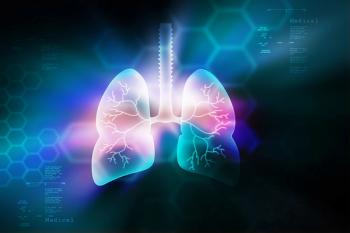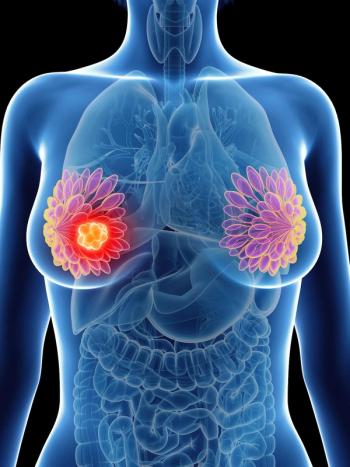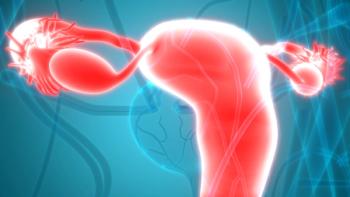
- ONCOLOGY Vol 9 No 8
- Volume 9
- Issue 8
Commentary (Kinsella): Current Status of Radiation Sensitization by Fluoropyrimidines
Drs. Pu, Robertson, and Lawrence provide a concise update of recent laboratory and clinical studies of fluoropyrimidine radiosensitization. From a clinical perspective, one can conclude that this drug-radiation interaction appears to be greater than additive and clearly has resulted in significant therapeutic gains, particularly for gastrointestinal cancers, as summarized in Tables 2 and 3 of their article. From a laboratory perspective, the focus has now shifted to trying to better understand the mechanisms of the interaction as related to molecular events at the G1/S interphase and in early S phase.
Drs. Pu, Robertson, and Lawrence provide a concise update of recent laboratory and clinical studies of fluoropyrimidine radiosensitization. From a clinical perspective, one can conclude that this drug-radiation interaction appears to be greater than additive and clearly has resulted in significant therapeutic gains, particularly for gastrointestinal cancers, as summarized in
In order to understand the design of the present generation of clinical trials, it may be useful to briefly highlight the nearly 40-year history of translational research on fluoropyrimidine radiosensitization. Shortly after Heidelberger synthesized fluorouracil and the deoxyuridine analog floxuridine (FdUrd [FUDR]) in 1957 at the University of Wisconsin, experimental studies of the combination of fluorouracil and x-rays were performed by his group in mice bearing sarcoma 180 tumors. An intraperitoneal dose of fluorouracil for 7 days showed no tumoricidal effect when administered alone but resulted in significant tumor responses when followed by a single dose of x-rays. Approximately a decade later, Vietti and colleagues first showed the influence of the sequence (timing) of administration of fluorouracil and radiation in mice with a transplanted leukemia cell line. Greater than additive effects were reported if the drug was given 14 to 24 hours before radiation, and this interaction was even more pronounced when fluorouracil was given up to 8 hours after radiation.
At about the same time, clinical investigators at the Mayo Clinic and the University of Wisconsin reported the first prospective trials of fluorouracil plus irradiation in unresectable gastric cancer and locally advanced head and neck cancers, respectively. These trials showed a survival benefit to low-dose bolus-infusion fluorouracil (15 mg/kg/d 3 days) when given in weeks 1 and 5 of conventional radiation therapy. Since the dose of fluorouracil was so low, most clinicians have interpreted these data to support the role of fluorouracil as a radiosensitizer. Indeed, a similar intermittent, low-dose bolus schedule of fluorouracil was found to be effective as a radiosensitizer in resected rectal cancer in the more recent Gastrointestinal Tumor Study Group (GITSG) studies 7175 and 7180, as detailed in the review by Pu et al.
The recently completed combined-modality studies in resected stage 2 and 3 rectal cancer conducted by the North Central Cancer Treatment Group (NCCTG) and in locally advanced esophageal cancer by the Radiation Therapy Oncology Group (RTOG) demonstrated a survival advantage to longer (96-hour) fluorouracil infusions compared to higher-dose bolus infusion, although still given in weeks 1 and 5 of a 6-week course of radiation (
Mechanisms of Interaction Remain to Be Clarified
We are now faced with an unusual dilemma for clinical oncology. The flow of ideas and information from the laboratory to the clinic perhaps has been reversed for fluoropyrimidine radiosensitization. Randomized clinical trials have demonstrated the benefit of fluorouracil and radiation, and yet the mechanisms of the interaction remain to be clarified in the laboratory.
Unfortunately, the 1980s produced mostly conflicting laboratory studies in this area: Some in vitro data suggested that a greater than additive effect was found in human tumor cell lines, but only with regimens consisting of postirradiation exposure to cytotoxic doses of fluorouracil. In vivo studies showed additive effects only from the fluorouracil-radiation interaction, with this effect dependent primarily on the total dose of fluorouracil and little difference in effect from the mode (bolus vs prolonged infusion) and schedule (before vs after radiation therapy) of drug administration.
As a consequence, the design of current clinical trials is based on enhancing the cytotoxic effects of fluorouracil by means of either biochemical modulators (leucovorin and/or levamisole [Ergamisol]), as in the ongoing adjuvant rectal cancer trials, or additional cytotoxic drugs such as cisplatin (Platinol), which may also interact with fluorouracil and/or radiation, as found in clinical trials of esophageal and anal cancers.
Timing of Radiosensitization
With the recent renewed interest in cell-cycle regulation throughout basic and translational cancer research, there are now several lines of investigation that point to the G1/S interphase and early S phase as potentially important times for fluoropyrimidine radiosensitization:
First, both the University of Michigan group and our group have recently correlated enhanced in vitro radiosensitization using minimally cytotoxic doses of fluorouracil or floxuridine with an expansion of an early S-phase population in several human cancer cell lines [1-7].
Second, the work of Kastan, Fornace, Lowe, and several others have documented activation of several important transcription factors in a progressive cascade at the G1/S checkpoint following radiation-induced DNA double-strand breaks [8].
Based on these studies, the following working hypothesis has been formulated: If cellular repair mechanisms (presumably including the activation of deoxyribonucleotide regulatory enzymes) are intact, a G1/S block occurs to allow adequate time for repair of radiation damage. If events at the G1/S checkpoint are altered, however, progression into S phase occurs with incomplete repair or misrepair of radiation damage.
How might this eloquent molecular cascade for radiation damage repair be altered by fluorouracil? Although the answers are far from complete, it is most likely that the alteration results, at least in part, from thymidylate synthase (TS) inhibition with consequent effects on p53 expression [9]. Several additional clinically relevant questions arise, including the following:
- Will tumors with initially high TS levels be refractory to the fluorouracil/radiation interaction, as has been shown for fluorouracil cytotoxicity (using the human TS monoclonal antibody) [10]?
- Is mutant p53 protein expression a necessary component for fluoropyrimidine radiosensitization?
Perhaps the answers to these and related questions will better prepare us to design the next generation of clinical trials of fluoropyrimidine radiosensitization.
References:
1. McGinn CJ, Miller EM, Lindstrom MJ, et al: The role of cell cycle redistribution in radiosensitization: Implications regarding the mechanism of fluorodeoxyuridine radiosensitization. Int J Radiat Oncol Biol Phys 30:851-859, 1994.
2. Bruso CE, Shewach D, Lawrence TS: Fluorodeoxyuridine-induced radiosensitization and inhibition of DNA double strand break repair in human colon cancer cells. Int J Radiat Oncol Biol Phys 19:1411-1417, 1990.
3. Miller EM, Kinsella TJ: Radiosensitization by fluorodeoxyuridine: Effects of thymidylate synthase inhibition and cell synchronization. Cancer Res 52:1687-1694, 1992.
4. Heimburger DK, Shewach DS, Lawrence TS: The effect of fluorodeoxyurdine on sublethal damage repair in human colon cancer cells. Int J Radiat Oncol Biol Phys 21:983-987, 1991.
5. Lawrence TS, Davis MA, Maybaum J: Dependence of 5-fluorouracil-mediated radiosensitization on DNA-directed effects. Int J Radiat Oncol Biol Phys 29:519-523, 1994.
6. Lawrence TS, Maybaum J, Ensminger WD: Infusional fluoropyrimidines as radiation sensitizers: Clinical implications of laboratory findings. Infusional Chemotherapy 1995 (in press).
7. Davis MA, Tang HY, Maybaum J, et al: Dependence of fluorodeoxyuridine-mediated radiosensitization on S phase progression. Int J Radiat Biol 1995 (in press).
8. Marx J: New link found between p53 and DNA repair (editorial). Science 266:1321-1322, 1994.
9. Chu E, Copur S, Jones KL, et al: Thymidylate synthase regulates the translation of p53 mRNA (abstract). Proc Amer Assoc Cancer Res 36:563, 1995.
10. Johnston PG, Fisher ER, Rockette HE, et al: The role of thymidylate synthase expression in prognosis and outcome of adjuvant chemotherapy in patients with rectal cancer. J Clin Oncol 12:2640-2647, 1994.
Articles in this issue
over 30 years ago
Sociobiology and Cervical Cancerover 30 years ago
Cigarette Smoking Among Adults--United States, 1993over 30 years ago
New Lymphatic Mapping May Avoid Many Axillary DissectionsNewsletter
Stay up to date on recent advances in the multidisciplinary approach to cancer.



















































































